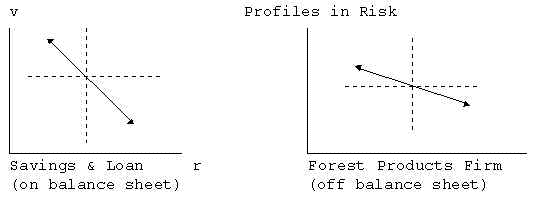
Managing Financial Risk, Smithson & Smith
Chapter 5
Measuring A Firm's Exposure To Financial Price Risk
by: Mark Glitto
Questions a CFO should ask:
- Can my firm be put out of business by volatility?
- What is my exposure to interest rate, FX, commodity price risk?
____________
Profiles in Risk

Important issue is the slope of risk profile, dv/dr
Financial Price Risk Reflected in the Firm's Financial Statements
I. Balance Sheet
Illustration 5-1
·Firm's Liquidity
Note that liquidity can substitute for risk management.
current ratio: current assets/current liabilities
quick ratio: cash + receipts/current liabilities
·How highly leveraged is the Firm?
Amount of debt
Off balance sheet leverage i.e. leases, look at the footnotes in
financial
·FX Exposure
Translation exposure, e.g. foreign subsidiaries or operations.
Transaction exposure, mismatch between currency received and being paid out.
Long term: "repatriation of profits."
·Interest Rate Exposure
Floating rate debt
Asset - Liability Maturity Rate Gap
II. Statement of Consolidated Income
Questions to ask
*what is the state of the market for the firm's output?
* are the companies cost changing relative to income?
* are there foreign exchange exposures?
*who well is the firm carrying its debt?
Example Illustration 5-3
+ Net sales up 22%
+ Selling cost have risen by only 4%
-- COGs increased dramatically
-- interest and FX expense up dramatically
Statement of Changes in Financial Position
Illustration 5-4
- Quality of earnings
Discontinued operations, one time shut down of operation.
Extraordinary Items, one time court award.
Adding floating rate short term debt.
Pension fund policies losses realized in internally managed portfolio
III. Letter to Shareholders in the Annual Report
contingent (strategic) exposure
Illustration 5-5 p.135
·Cooper user and cooper prices increase.
·Asian components purchased and value of Yen increases.
Two Ways to Make Internal Measures of Financial Risk
1. Statistical Analysis (Regression)
Problem: will the data hold true in the future? Not accurate in new markets. Also issue that accounting data does not take into consideration opportunity costs.
2. Simulation Analysis (Monte Carlo)
Advantage of in-depth understanding of firm exposure and a fuller set of assumptions can be explored.
----------------------------
Derivatives are a means to an end; they have flourished because they allow an individual or a firm a way of measuring the effects of future price uncertainty. But in so doing, they serve another purpose - they transmit information about how market participants feel about the future. Seen from this perspective, derivatives are integral to the efficient functioning of economics and the markets; in an informal sense they link the present to the future.
Lillian Chew, Managing Derivative Risks